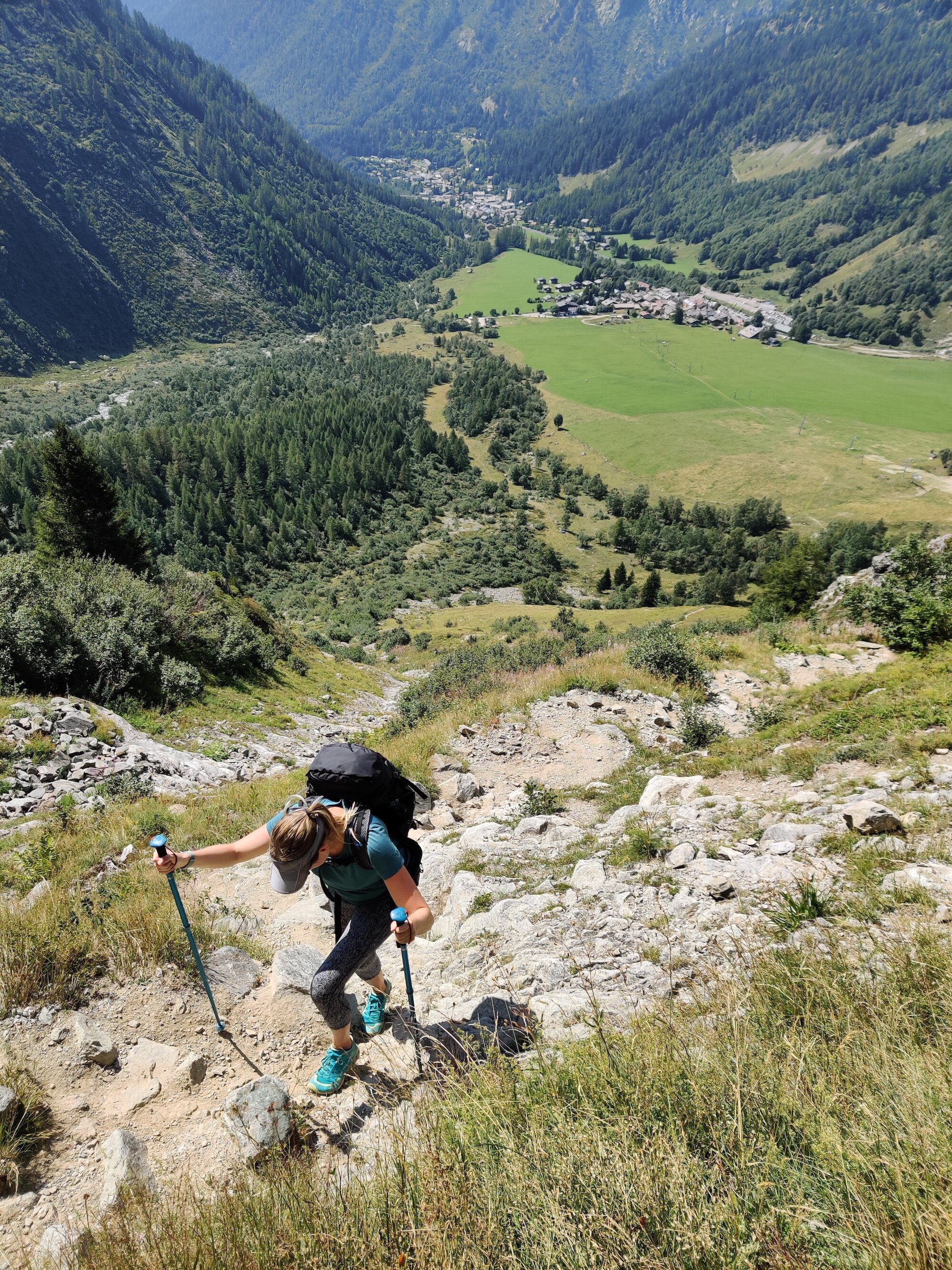Hiking in the Alps is an awe-inspiring experience, but it can also be physically demanding. Long distances, steep climbs, and rugged terrain can put a strain on your body. That's where hiking poles come in. Hiking poles are essential gear for long-distance hiking in the Alps. They provide a number of physical benefits that can help you hike more comfortably and efficiently.
The benefits of using hiking poles
Reducing muscle fatigue using hiking poles on steep ascents and descents will significantly help on your multi-day hike. This ascent up to Le Tour Glacier (along Tour du Mont Blanc and Walker’s Haute Route) is particularly steep, rocky and uneven.
Improved Cardiovascular Fitness
Hiking poles can help to improve your cardiovascular fitness by increasing your body’s physiological responses, such as heart rate, oxygen consumption / utilization and energy expenditure. This is because you are using more muscle groups and working harder overall, not just in your legs.
Reduced Muscle Fatigue
Hiking poles can help to reduce muscle fatigue by engaging more muscle groups. This is because you are using your arms and shoulders to help propel yourself forward, in addition to your legs. In fact, a study published by the National Library of Medicine, outlines that there is a 300% increase in triceps activation, when using poles while hiking uphill.
Improved Balance and Stability
Hiking poles can help you to improve your balance and stability, particularly on uneven terrain, by increasing the base of support, or how large your touch point with the ground is. This is especially important when crossing streams, climbing over rocks, or hiking in snow or ice.
Increases Stride Length
Using hiking poles can allow you to increase your stride length, making the amount of ground that you cover in your walking pattern a little bit more efficient.
Reduced Impact on Knees and Joints
Hiking poles help to reduce the impact on your knees and joints by transferring some of the weight of your backpack to your arms and shoulders. This is especially important on long descents, when the force of gravity is pulling you downhill. The study published by National Library of Medicine states that using hiking poles can reduce the amount of force going up and down through your body by about 12-16%. This is a significant reduction when you are hiking back-to-back days on the trail and your body’s physical aches and pains are accumulating.
Watch this excerpt from our recent webinar "How to prepare for a multi-day hike in the Alps", presented by Stacey Hardin, Founder of Pique to Peak, to learn more about what the science says about using hiking poles.
How to Choose Hiking Poles
When choosing hiking poles, there are a few things to consider:
Material: Hiking poles are typically made from aluminum, carbon fiber, or a combination of the two. Aluminum poles are less expensive and more durable, while carbon fiber poles are lighter and stiffer.
Length: The length of your hiking poles should be adjusted so that your elbows are bent at a 90-degree angle when you are holding the poles. If you are purchasing online, use this guide:
Height (<5 ft. 1in or <155cm) = 100cm pole length
Height (5ft 1-7in or 155-170cm = 110cm pole length
Height (5ft 8-11in or 170-180cm = 120cm pole length
Height (>6ft or>180cm = 130cm pole length
Features: Some hiking poles have features such as adjustable length, foldable shaft, shock absorbers, and ergonomic grips. These features can add comfort and convenience, but they are not essential.
Here is an example of three different hiking poles from Black Diamond. The set on the left is made from Carbon Fiber, extends to 130cm, has a cork grip and interchangeable tips ($199USD). The set in the middle is made from Aluminium and also extends to 130cm ($59USD). The set on the right is a lightweight, foldable set made from Aluminium that you can purchase in a variety of lengths ($140USD).
How to Use Hiking Poles
When using hiking poles, there are a few basic techniques to keep in mind:
Plant the poles in front of you, not behind you. This will help to propel you forward and reduce the impact on your knees and joints.
Keep your arms close to your body. This will help to improve your balance and stability.
Use a rhythmic motion. Swing your arms naturally and in time with your steps.
Adjust the length of your poles as needed. The length of your poles should be adjusted so that your elbows are bent at a 90-degree angle when you are holding the poles.
Hiking poles are essential for climbs like this one in the Mattertal Valley near Zermatt, along the Walker’s Haute Route.
Hiking with One Pole or Two?
Deciding between hiking with one pole or two involves considering terrain, balance, and preferences. Using two poles provides more stability, balance, and support on challenging terrain, especially for those with balance issues or carrying a heavy backpack. One hiking pole is suitable for less demanding trails, promotes natural arm movement, and offers flexibility in scrambling and climbing. Make sure to practise using your hiking poles in the lead up to your hike so you are comfortable when you set foot in the Alps.
Using two poles (and a baquette!) was essential while hiking the Tour of Monte Rosa which has rocky terrain, uneven trails and even a glacier crossing!
Bringing hiking poles on the plane
Bringing hiking poles on a plane is generally permitted, but there are some restrictions. Hiking poles with sharp tips or spikes may be considered a weapon and therefore not allowed in carry-on luggage. It's best to pack hiking poles in checked luggage or remove the tips and pack them separately in carry-on luggage. Airlines may have different policies, so it's advisable to check with the airline before traveling.
Buying hiking poles when you arrive
If you don’t want to bring your hiking poles with you, whether due to luggage restrictions or if you are traveling prior to your multi-day hike, you can purchase hiking poles in most outdoor stores in the Alps.
SUMMARY
Hiking poles are a valuable tool for long-distance hiking in the Alps. They can help to reduce the impact on your knees and joints, improve your balance and stability, reduce muscle fatigue, and improve your cardiovascular fitness. By choosing the right hiking poles and using them properly, you can make your hiking experience more comfortable and enjoyable.
When poles are necessary, a light pair will make it easy to carry in one hand. Image from Alta Via 1 Dolomites, on the first ascent from Lago di Braies.
Susan, co-founder of The Hiking Club, fell in love with the Alps while on a student exchange to Switzerland during high school. Her favourite part of the Alps is the maintained trail network, delicious food along the trail and spending time with her family in the outdoors.









